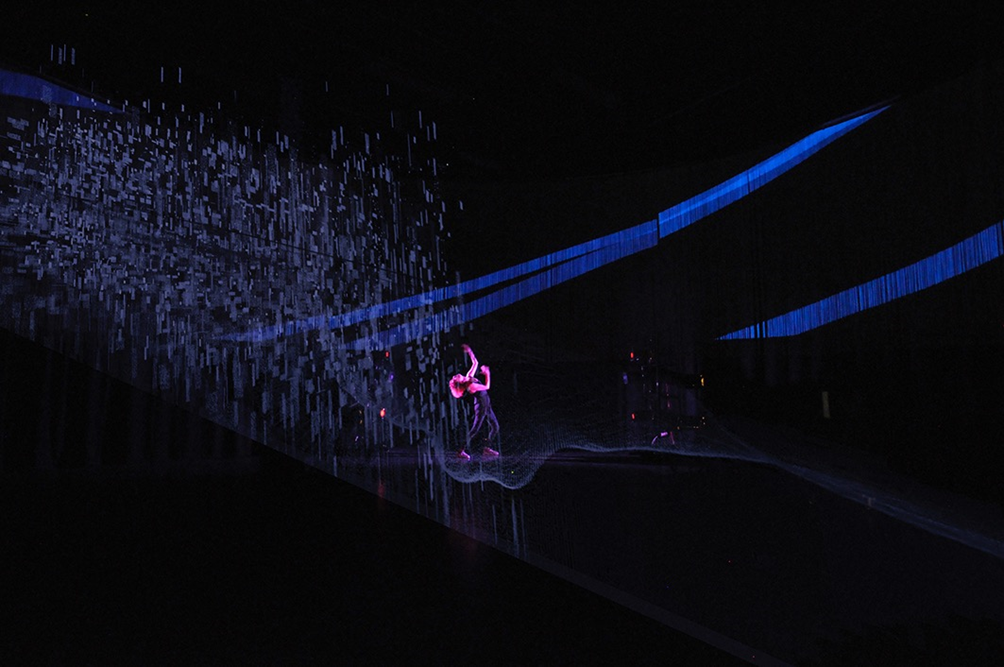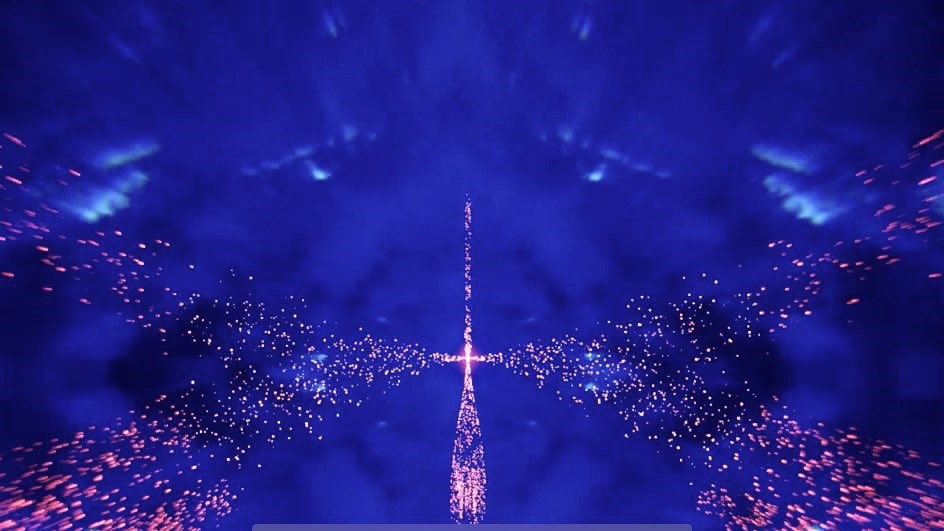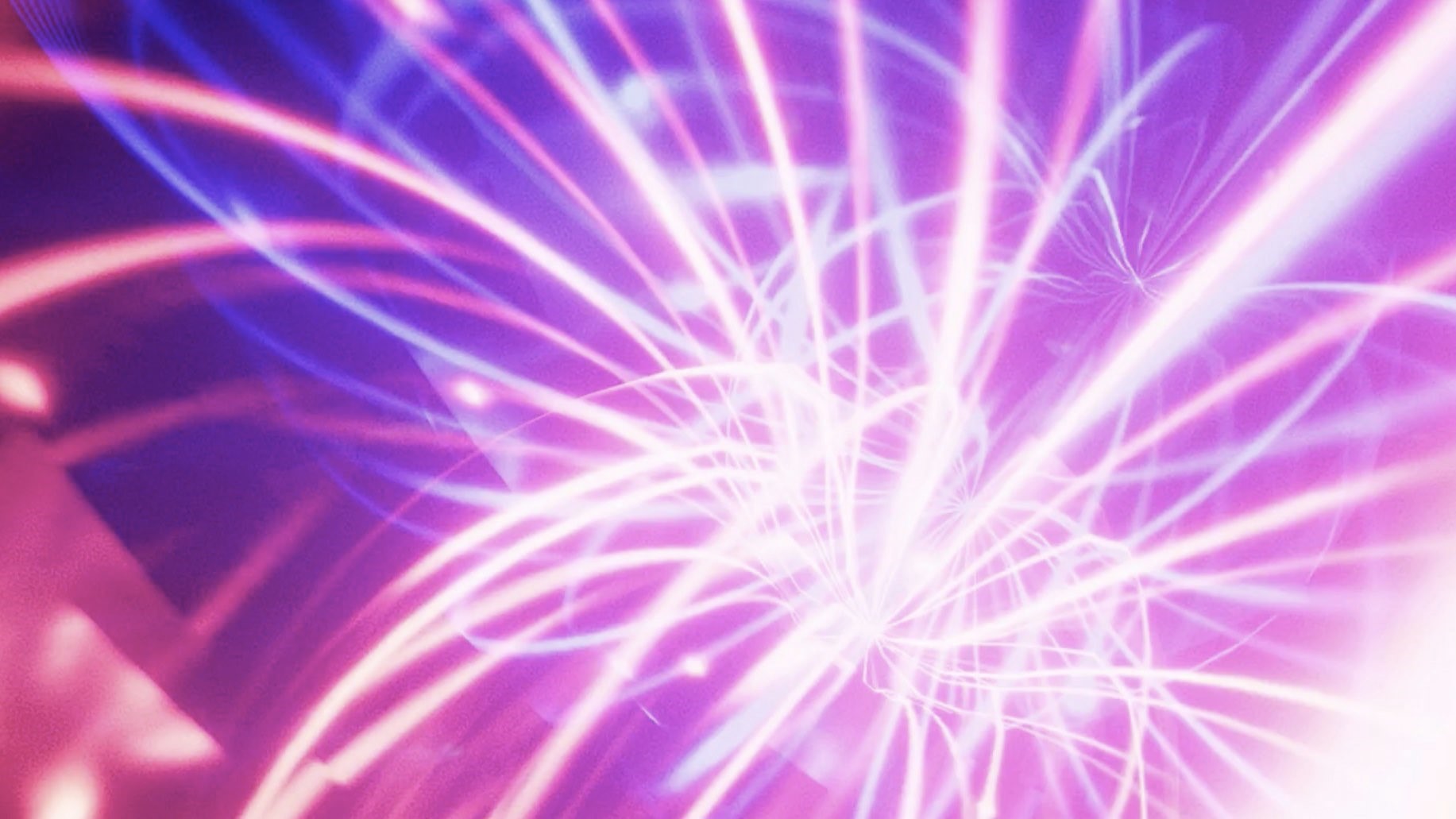As an artist whose work spans performance art, music, sound, light, architecture, and virtual reality, Vesna Petresin’s perspective is in great demand. In addition to designing Lumisonica for The Mint Museum, Vesna has had a busy year full of exciting projects. During the last six weeks alone, she presented at three major events: the Netherlands Film Festival (Utrecht, The Netherlands, September 27 – October 5); the Beyond Festival and Symposium (Center for Media Arts, Karlsruhe, Germany, October 3 – 7); and VR Days Europe (Amsterdam, October 24 – 26). Additionally, she gave a talk at the TNW Conference at the Technical University of Munich in March, and since January has served as an Artist-in-Residence at the Amsterdam Academy for the Arts.

Vesna Petresin performing in Open Studio, a mixed reality experience, ID Lab, Theatre and Dance Academy, Amsterdam 2018
According to its website, the Netherlands Film Festival is “the leading platform for the Netherlands’ national film culture. It celebrates the achievements of Dutch filmmakers and provides the bridge between film culture and all facets of Dutch society….It is active throughout the year, stimulating and promoting Dutch film culture before the 9-day extravaganza in late September” when the best productions of the previous 12 months are presented. “These days, cinema is more than just films, and so NFF incorporates into its program disciplines that draw inspiration from, and themselves influence, the cinematic narrative form, from TV drama, music, and visual arts to games and interactive productions.” This year was the festival’s 38th year.
Vesna spoke on a panel in the “Our Brave New World” session, moderated by Dr. Dan Hassler-Forest, a researcher, writer, and lecturer at Utrecht University. In Vesna’s words, this panel was “about the utopian and dystopian aspects of new imaging and media technologies.” In describing her talk, entitled “The Real and the Virtual of VR,” she wrote, “The strength of Virtual Reality is that it offers the possibility to experience artificial realities as real: time and space fused into a “modulated” reality. Within this medium, my performance work has a strong idiosyncratic signature, exploring the medium in various contexts. My work is in transdisciplinary art and Research & Development – through performance and public art I examine the processes of transformation and the concept of time.”
Following her talk, Vesna presented Matter = Information, a new immersive sound and light VR experience for HTC Hive, which she created in collaboration with the Dutch VR developer Aron Fels.

Vesna Petresin and Aron Fels, still image from Matter = Information, 2018
The theme for this year’s Beyond Festival was Virtual Reality, Artificial Intelligence and Post-Capitalism. Its website states: “Within the coming decades new technologies are going to change our lives and the way we perceive it beyond our expectations. The BEYOND Festival is a creative collaboration of science, technology and art, an experimental laboratory for new forms of art, which simultaneously offers a glance at social effects regarding new technologies in a global context…It is a festival of films, audio-visual installations and additionally a symposium which exhibits new forms of art and media, such as 2D, 3D, artificial intelligence, virtual-, mixed- and augmented reality.”
Vesna expanded on the idea of matter as information in her talk, “Present Continuous.” She describes the talk thusly: “As the world of technology focuses on the process from bits to particles and from particles back to bits, the impact of social change through technology gives rise to a digital world order. Here, our value is defined by what we contribute to data processing. The culture of flow, Interaction, sharing, tracking, prosuming [serving as both producer and consumer], redefines ways in which we learn, work, trade, communicate and relax. In the world when the ancient myths are fused with emergent godlike technologies such as artificial intelligence and genetic engineering, how will we define what it means to be human?” Vesna presented similar ideas in her talk at the Technical University of Munich in March.
After the talk Vesna again presented the VR experience, Matter = Information.

Vesna Petresin and Aron Fels, still image from Matter = Information, 2018
For the exhibition portion of the Beyond Festival, Vesna showed The Scores of Chaos, a VR experience based on composer György Ligeti’s musical notation, which she created with a team in Amsterdam called the XR Base Unit. They worked at XRBASE Amsterdam, a co-working space and production company for immersive content that has locations across Europe. Vesna has worked with XRBASE Amsterdam (formerly known as VRBase) on several projects, including content visualization and modeling for Lumisonica.

Still image from The Scores of Chaos | Executive producer: Daniel ‘Kip’ Doornink | Fractal artist: Julius Horsthuis |Creative coders: Sander Sneek, Ruud op den Kelder | Creative advisor: Vesna Petresin | Voice-over audio: Whoozy Music | Supported by XMG, Sensiks
All music by György Ligeti performed by Pierre-Laurent Aimard and Cappella Amsterdam.
Vesna writes, “The Scores of Chaos is an immersive experience, commissioned by Muziekgebouw (Amsterdam 2018) as an homage to the musical genius of the contemporary Hungarian composer Ligeti.
His music featured in some of the most iconic scenes in Stanley Kubrick’s work, making this collaboration groundbreaking for the history of the moving image. Ligeti’s fascination with the world of fractals, chaos and multisensory experience of music, has been the inspiration behind an imaginary trip into the world of his scores. Music becomes an immersive visual landscape, a doorway into the otherworldly beauty of mathematics, of our imagination, and the universe.”
György Ligeti’s music also inspired Vesna’s sound composition for Lumisonica.
VR Days Europe is “a conference and exhibition focused on Virtual, Augmented, and Mixed Reality XR content, creativity, and innovation” comprising keynotes, sessions, workshops, and seminars led by “over 140 thought leaders and experts drawn from the health, technology, business, and arts sectors.”
Vesna presented a talk at the Museum Morning panel, at which creators, producers and artists shared projects that successfully used XR (X Reality) technology in the museum and heritage sector. The panel’s moderator was Daan Kip, a co-founder of VR Days Europe and founder of the XRBASE network. Other panelists included Nina Diamond, Content Manager at the Metropolitan Museum of Art.
Vesna’s talk, “Immersive Ambients,” discussed how “Interactive media allow us to create immersive environments and experiences outside of the ‘white cube’ of a gallery or the ‘black box’ of a theatre.” She writes, “To create a fusion of the built environment and the media, my practice utilizes the conceptof a smart, playable city…. People actively shape their environment; my work attempts to render visible and audible the impact we have on the world – on the shapes, colors, sounds, emotions, social experiences and physical processes – simply by being here.” She discussed Lumisonica, among other projects.
Vesna also hosted a session in the Philosopher’s Salon, a yurt where visitors took off their shoes, refrained from using technology, and discussed questions surrounding XR technology such as human relationships with virtual characters and the ethical implications of humans carrying out acts in virtual environments that are illegal in the real world.
Vesna’s talk, another version of “Present Continuous,” focused on presence in Virtual, Physical, and Mixed Reality. “As our present looks increasingly dystopian, questions arise about the future and the impact of social change through technology, while a new digital world order seems to be taking shape. A sense of presence in virtual worlds is akin to an escape from the trauma of existence. a largely disembodied experience allowing to play god. Rethinking the philosopher Montaigne, the sensory perception may well be synonymous with sensory illusion, as the meaning of the truth seems to become intangible, and commodified,” she writes of her talk. Afterward she led a conversation among salon visitors.
Throughout her research and artistic practice, Vesna Petresin engages with pressing questions around the relationship between humans and technology in the twenty-first century. Lumisonica extends that inquiry to the environment of The Mint Museum, creating an enhanced experience in which visitors’ interactions with the technology on the staircase lead to new perceptions of their effect on the spaces they inhabit. Come to the debut of Lumisonica at Mint Museum Uptown at Levine Center for the Arts, 500 South Tryon Street, on Friday night, November 16, from 6 to 9 PM to experience it yourself.
A project as complex and technologically advanced as Lumisonica requires close collaboration among many people. And while it may seem ironic for a project involving digital technology, the best format for such collaboration is through face-to-face meetings. For this reason, Vesna Petresin traveled from her current home base of London to The Mint Museum to work on Lumisonica on October 9 and 10. She spent much of her time with two key people: Creative Design Lead Ben Mason, who is based in Asheville, and lighting consultant Terry Reeves, who also traveled from London.
Lumisonica, the interactive light and sound installation designed by Vesna Petresin for the Grand Staircase at Mint Museum Uptown and scheduled to debut this November, marks the Mint Museum’s first experience with this kind of multimedia, interdisciplinary, intangible art. To recap a previous blog post, Lumisonica is “based on the concept of a smart, playable city. It encompasses disciplines from architecture, lighting design, sound design, choreography and set design, to interactive visual arts.” (more…)
Standing in a round sound stage in Vesna Petresin’s studio in the ID Lab, up several flights of stairs at the Academie voor Theater en Dans, (Theater and Dance Academy) a division of the University of the Arts (AHK), Amsterdam, I am literally in the middle of light and sound experiments for Lumisonica. (more…)
The Mint Museum is pleased to announce that it has selected internationally-renowned artist Vesna Petresin to create a ![]() . The project is being funded through a generous grant from the John S. and James L. Knight Foundation, which challenged museums to use technology to enhance the visitor experience.
. The project is being funded through a generous grant from the John S. and James L. Knight Foundation, which challenged museums to use technology to enhance the visitor experience.
“Ever since Mint Museum Uptown opened in 2010, we have sought ways to interface more directly with Levine Center for the Arts plaza, by enlivening the front of the building to be more welcoming to our visitors,” said Jonathan Stuhlman, Senior Curator of American, Modern, & Contemporary Art.
“After a careful review of more than three dozen applicants, our team felt that Vesna’s proposal was a perfect blend of interactivity, innovation, and aesthetics. We are excited to work with her to bring her vision—and the entrance to the museum—to life!” said Annie Carlano, Senior Curator of Craft, Design, & Fashion.
Petresin, born in Ljubljana, Slovenia, is a trans-disciplinary artist who has exhibited and performed at the Tate Modern; ArtBasel Miami; the Royal Academy of the Arts; the Venice Biennale; the Institute of Contemporary Arts London; and the Vienna Secession. She is represented by Bonnie Hall Fine Art Asset Management. Her installation, Lumisonica, will map the physical movements of people on the museum’s steps, responding with a changing canvas of ambient light and sound.
Petresin will work with her team, including regional and city of Charlotte consultants, to design, test, and create the installation throughout the spring and summer. Work will continue while Mint Museum Uptown closes from early July through mid-August for a floor refinishing project (Mint Museum Randolph will remain open). It is scheduled to debut at a public celebration in September (details to be announced closer to the date).
Creating a multisensory landscape
This public art project transforms the museum’s main entrance into an unparalleled immersive experience that will be choreographed by the visiting public. Based upon the idea of the smart city, this multisensory landscape makes invisible space visible, audible, and tangible while aiming to increase people’s awareness that they can and do shape their own place, perceptions and reality. Lumisonica assures a daring and playful experience like no other in the heart of Charlotte’s flourishing art district. Juxtaposed near the large reflective Niki de Saint Phalle sculpture Firebird in front of the Bechtler Museum of Modern Art, this light and sound sculpture provides another dynamic feature to highlight entropic experiences, moiré patterns and other optical and perceptional illusions in this cultural area.
The “smart city” concept of this dynamic datascape is drawn from two components that change the form to an accessible visual/audio display based upon public movement and engagement:
Visual content is created by programmable LED light features embedded into the staircase and railings. The light effects include subtle, safe and non-intrusive animated patterns, designed to work interactively based on data captured from the environment as well as on presets of visual effects. The light effects are programmed along a 24/7 schedule with pre-rendered sets at specific times of the day, combined with responsive effects based on criteria such as visibility, program of events at the museum, and the number of visitors.
Audio content permeates ambient sound loops designed to respond and support the light effects. These amplify the visitor’s feeling of presence in the environment and assist their spatial navigation, by amplifying the ranges of frequencies that translate to embodied sensations. The audio content includes composed soundscapes and loops of sonic textures as well as key framed musical motifs on specific days and at specific times to announce events.
Additionally, the project plan is to expand from installation to an online digital experience through a contextual component set to provide an immersive experience exclusive to each visitor entering the website. In this way, Petresin allocates access to a wider public and allows the Mint visitor an ability to take with them a direct experience from their museum outing.
“My work tries to offer a moment to remember we inhabit and co-create a multisensory symphony,” said Petresin. “The piece for the Mint has been inspired by the idea that matter is information under constant transformation, bringing memory, human connection, wonder, and innovation.”
Petresin will also create a special sound and light sequence for Lumisonica as part of The Mint Museum’s exhibition Immersed in Light (Fall 2020 – Spring 2021). The exhibition will feature experiential lighting installations by four contemporary artists and designers in the Gorelick Galleries at Mint Museum Uptown.
Staircase to enhance museum experience, visitation
The Mint was among 12 recipients of $1.87 million in funding from the Knight Foundation for new ways of using technology to immerse visitors in art. Institutions in cities including Philadelphia, Detroit, Miami, Minneapolis, Chicago, and New York City are joining Charlotte in creating new tools ranging from chat bots to augmented reality apps to engage new audiences.
Funding for this project is part of a Knight Foundation initiative to help museums better meet new community demands and use digital tools to meaningfully engage visitors in art. Knight, which promotes informed and engaged communities, has helped institutions—from newsrooms to libraries—adapt to and thrive in the digital age. This funding expands the foundation’s use of its digital expertise to help art museums build stronger, more vibrant communities.
“The arts have the rare power to bring diverse communities together, provoke personal reflection, and inspire new ways of thinking,” said Victoria Rogers, Knight Foundation vice president for the arts. “Our hope is that by integrating technology, museums can better reach and engage audiences in ways that connect them to the art.”
Above image: Concept rendering for Mint Museum Uptown Grand Staircase installation titled Lumisonica, courtesy of Vesna Petresin.
ABOUT VESNA PETRESIN
Vesna Petresin is currently an Artist-in-Residence at Amsterdam University of the Arts and a Visiting Fellow at Goldsmiths (University of London). She has been an Artist in Residence at ZKM in Germany and created a London-based trans-disciplinary art collective whose exploration of optics, acoustics and psychology takes the format of performance, installation and artifact.
As a time architect, non-object based designer, space composer and performer, her practice utilizes an alchemy of media and senses (sound, film, space, interaction, and performance) to take art out of the white cube and bring it into an immersive experience. The key concept is transformation—of the material, the immaterial and the self.
Petresin seeks elements to link cultures rather than separate them and pays attention to archetypal formal constants and patterns existing in nature, human perception and the creative process. Her work in immersive light is ground-breaking and has been featured at Tate Modern, ArtBasel Miami, Venice Biennale, The Royal Festival Hall, The Royal Academy of Arts, ICA, The Sydney Opera House, Vienna Secession, Cannes International Film Festival and Kings Place among others.
Petresin’s academic background in classical music and architecture has propelled her as a Fellow of the Royal Society of the Arts, a Member of the Architectural Association, a keynote speaker at symposia including “SuperLux: Smart Light Art, Design and Architecture for Cities” (Technical University of Munich, 2016), the XR Summit ( ISE at RAI, Amsterdam 2018) and a print author of internationally notable publications. She has written on smart cities (Thames & Hudson, Black Dog) and on Leonardo da Vinci’s creative methods in relation to 21st century view of morphogenesis in art and design for Springer Publications.
ABOUT THE JOHN S. AND JAMES L. KNIGHT FOUNDATION
Knight Foundation is a national foundation with strong local roots. We invest in journalism, in the arts, and in the success of cities where brothers John S. and James L. Knight once published newspapers. Our goal is to foster informed and engaged communities, which we believe are essential for a healthy democracy.